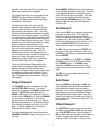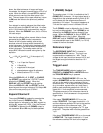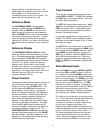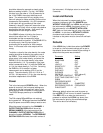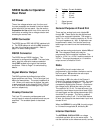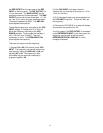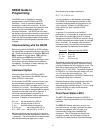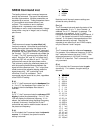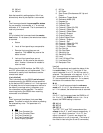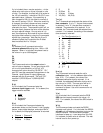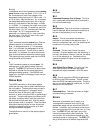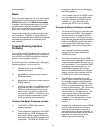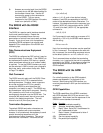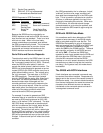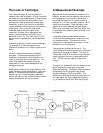
21
SR530 Command List
The leading letters in each command sequence
specify the command. The rest of the sequence
consists of parameters. Multiple parameters are
separated by a comma. Those parameters shown
in {} are optional while those without {} are
required. The variables m and n represent
integers while v represents a real number.
Parameters m and n must be expressed in integer
format while v may be in integer, real, or floating
point format.
AX
AY
AR
AP
The A command causes the auto offset (rel)
function to execute. Auto offset is performed by
reading the output and using that value as the
appropriate offset. Every time an "AX" command
is received, the auto offset function is executed on
the X output. The "AY" command auto offsets the
Y output. The "AR" command auto offsets the R
output. Note that "AX" and "AY" will affect the R
output but "AR" will not affect X and Y. The "AP"
command will execute the auto-phase routine.
This is done by setting the reference phase shift
with the present phase difference between the
signal and the reference input. The ¯ output then
reads zero and the reference display reads the
signal phase shift. "AP" maximizes X and
minimizes Y but R is unaffected. The A
commands may be issued at any time, regardless
of the DISPLAY setting.
B {n}
If n is "1", the B command sets the bandpass filter
in. If n is "0", the bandpass filter is taken out. If n
is absent, then the bandpass filter status is
returned.
C {n}
If n is "1", the C command sets the reference LCD
display to show the phase setting. If n is "0", the
LCD will display the reference frequency. If n is
absent, the parameter being displayed (frequency
or phase) is returned. Note that the P and F
commands are used to read the actual values of
the phase and frequency.
D {n}
If n is included, the D command sets the dynamic
reserve. If n is absent, the dynamic reserve
setting is returned.
nDyn
Res
0LOW
1 NORM
2 HIGH
Note that not all dynamic reserve settings are
allowed at every sensitivity.
E m {,n}
The E command sets and reads the status of the
output expands. If m is "1", then Channel 1 is
selected, if m is "2", Channel 2 is selected. The
parameter m is required. If n is "1", the E
command expands the selected output channel. If
n is "0", the expand is turned off for the selected
channel. If n is absent, the expand status of the
selected channel is returned. Note that the
expands do not affect the X and Y BNC outputs,
only the Channel 1 and 2 outputs.
F
The F command reads the reference frequency.
For example, if the reference frequency is 100 Hz,
the F command returns the string "100.0". If the
reference frequency is 100.0 kHz, the string
"100.0E+3" is returned. The F command is a read
only command.
G {n}
If n is included, the G command sets the gain
(sensitivity). If n is absent, the gain setting is
returned.
n Sensitivity
1 10 nV
2 20 nV
3 50 nV
4 100nV
5 200nV
6 500nV
71 µV
82 µV
95 µV
10 10 µV
11 20 µV
12 50 µV
13 100µV
14 200µV
15 500µV
16 1 mV
17 2 mV
18 5 mV
19 10 mV
20 20 mV
21 50 mV
22 100mV



